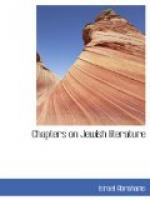A far more important work was written by the first Jewish explorer of Palestine, Esthori Parchi, a contemporary of Mandeville. His family originated in Florenza, in Andalusia, and the family name Parchi (the Flower) was derived from this circumstance. Esthori was himself born in Provence, and was a student of science as well as of the Talmud. When he, together with the rest of the Jews of France, was exiled in 1306, he wandered to Spain and Egypt until the attraction of the Holy Land proved irresistible. His manner was careful, and his love of accuracy unusual for his day. Hence, he was not content to collect all ancient and contemporary references to the sites of Palestine. For seven years he devoted himself to a personal exploration of the country, two years being passed in Galilee. In 1322 he completed his work, which he called Kaphtor va-Pherach (Bunch and Flower) in allusion to his own name.
Access to the Holy Land became easier for Jews in the fourteenth century. Before that time the city of Jerusalem had for a considerable period been barred to Jewish pilgrims. By the laws of Constantine and of Omar no Jew might enter within the precincts of his ancient capital. Even in the centuries subsequent to Omar, such pilgrimages were fraught with danger, but the poems of Jehuda Halevi, the tolerance of Islam, and the reputation of Northern Syria as a centre of the Kabbala, combined to draw many Jews to Palestine. Many letters and narratives were the results. One characteristic specimen must suffice. In 1488 Obadiah of Bertinoro, author of the most popular commentary on the Mishnah, removed from Italy to Jerusalem, where he was appointed Rabbi. In a letter to his father he gives an intensely moving account of his voyage and of the state of Hebron and Zion. The narrative is full of personal detail, and is marked throughout by deep love for his father, which struggles for the mastery with his love for the Holy City.
A more ambitious work was the “Itinera Mundi” of Abraham Farissol, written in the autumn of 1524. This treatise was based upon original researches as well as on the works of Christian and Arabian geographers. He incidentally says a good deal about the condition of the Jews in various parts of the world. Indeed, almost all the geographical writings of Jews are social histories of their brethren in faith. Somewhat later, David Reubeni published some strange stories as to the Jews. He went to Rome, where he made a considerable sensation, and was received by Pope Clement VII (1523-1534). Dwarfish in stature and dark in complexion, David Reubeni was wasted by continual fasting, but his manner, though harsh and forbidding, was intrepid and awe-inspiring. His outrageous falsehoods for a time found ready acceptance with Jews and Christians alike, and his fervid Messianism won over to his cause many Marranos—Jews who had been forced by the Inquisition in Spain to assume the external garb of Christianity. His chief claim on the memory of posterity was his connection with the dramatic career of Solomon Molcho (1501-1532), a youth noble in mind and body, who at Reubeni’s instigation personated the Messiah, and in early manhood died a martyr’s death amid the flames of the Inquisition at Mantua.




